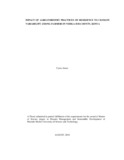| dc.description.abstract | Climate variability which is a reality in Kenya is manifested by fluctuations in climatic
parameters, low agricultural production, land fragmentation, soil degradation, and loss of
biodiversity. Addressing climate variability requires the use of ecologically based
traditional climate smart agriculture systems such as agro forestry. In the past decade
human lives, crops and livestock worth millions of shillings have been destroyed by
increased intensity of extreme weather events in Kenya. This study therefore intended to
examine the impact of agro forestry practices as a resilient mechanism for farmers
against the effects of climate variability in Vihiga Sub County, Kenya. The specific
objectives were to: (i) determine the agro forestry techniques practiced by farmers in
Vihiga Sub County; (ii) examine the rainfall and temperature variability trends in Vihiga
Sub County from 1985 to 2015 and (iii) evaluate the contribution of agro forestry
practices and products to households’ income as farmers’ resilience to Climate
Variability in Vihiga Sub County. Evaluation research design was used in this study. The
sample size involved 418 respondents. Stratified random sampling was used to get
farmer households by using the five locations in the sub county as strata. All the strata
had a target population of about 4184. Purposive sampling was used to sample relevant
organizations which included: ministry of agriculture, Kenya Agricultural and Livestock
Research Organization, International center for research and agro forestry, Kenya
meteorological department, Kenya sugar research foundation and District Agricultural
office staff. Quota sampling was used to identify respondents for focus group
discussions; the study used interview schedules to collect data from officers attached to
these organizations. Secondary data was collected from documentary analysis obtained
from these offices. Information on different trends in temperature, rainfall, agricultural
outputs and potential yields was obtained from these organizations. Data collected was
subjected to Analysis of Variance using Statistical Analysis Systems software version
8.0 to determine if agro forestry practices had significant effects on climate variability
and correlation-regression analyses were done to establish relationship(s) between key
variables on climate variability and agro-forestry practices. The results revealed that
multiple agro forestry practices have been adopted in the study area, they include mixing
trees with agricultural crops (7.7%), fruit trees with agricultural crops (6.7%), trees and
agricultural crops with animals (20.6%) and agricultural crops with pasture (44.8%) and
other agro forestry practices (20.2%) respectively. The chi square test at 0.01 gave a pvalue
of (0.006) indicating that there was statistically no significant difference between
agro forestry techniques and climate variability. Agro forestry has contributed to the
moderate climatic conditions experienced in the sub county while the increase in
temperature is attributed to global warming. The benefits of agro forestry in Vihiga sub
county range from planting trees as windbreaks (90.7%) to diversifying agricultural
products (17.4%) respectively. These results are useful in understanding the role of agro
forestry systems in enhancing farmers’ resilience to climate variability and thereby
reducing the level of vulnerability. The results will further assist policy makers in
formulating sound policies in matters pertaining to climate variability resilience | en_US |

